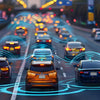TOF Technology at Intersections: Boosting Safety, Reducing Congestion

TOF Smart Traffic: Real-Time 3D Monitoring for Safer, Smarter City Intersections
In today’s urbanized world, efficient traffic management has become a critical challenge for city planners. Increasing congestion, frequent accidents, and low travel efficiency not only waste social resources but also exacerbate environmental pollution and affect citizens’ daily commutes. Traditional traffic monitoring systems, such as loop detectors, CCTV cameras, and manual patrols, provide limited insights and often fail to deliver high-precision, real-time, and adaptive solutions.
TOF (Time-of-Flight) technology, with its 3D sensing and millisecond-level depth measurement capabilities, is emerging as a transformative tool for smart city traffic management. By providing accurate vehicle flow data, TOF-based systems enable intelligent traffic lights, adaptive flow control, and enhanced accident prevention.
What Is Smart Traffic?
Smart Traffic refers to the application of modern information technology, communication networks, and sensing systems to monitor and optimize traffic conditions in real time. It aims to make urban mobility smoother, safer, and more efficient.
Key Features:
-
Real-Time Monitoring: Collect 3D road, vehicle, and pedestrian data using TOF sensors and complementary devices.
-
Intelligent Control: Optimize traffic lights, signal timing, and lane allocation through AI algorithms.
-
Predictive Planning: Forecast congestion patterns using historical and real-time data to guide routing decisions.
-
System Integration: Connect public transit, parking management, and emergency response systems for holistic traffic oversight.
Challenges of Traditional Traffic Management
Despite technological advancements, many cities still face obstacles with conventional monitoring methods:
-
Traffic Congestion: Fixed-timing traffic signals cannot respond dynamically to real-time road conditions, resulting in long queues and slow vehicle movement.
-
Frequent Accidents: Without high-precision, real-time data, accident response is often delayed, and risk mitigation is reactive rather than proactive.
-
Environmental Limitations: Cameras and loop detectors are affected by lighting, weather, and occlusions, reducing accuracy and coverage.
Cities need advanced sensing solutions capable of capturing reliable vehicle flow data in complex urban environments. TOF technology meets this need by producing precise 3D depth information and supporting real-time decision-making.
Advantages of TOF for Vehicle Flow Monitoring
TOF sensors emit light pulses and measure the return time to capture 3D information. Key advantages include:
-
High-Precision Vehicle Detection: TOF accurately identifies vehicle types, positions, and spacing, even in low-light or adverse weather conditions.
-
Environmental Robustness: Operates reliably under rain, fog, snow, and nighttime conditions, ensuring continuous traffic monitoring.
-
Real-Time Dynamics: Captures speed, direction, and lane positions at millisecond intervals, enabling adaptive traffic control and incident alerts.
-
Multi-Scenario Applicability: Supports intersections, tunnels, highways, and parking areas, integrating with V2X communication and AI platforms for comprehensive traffic oversight.
Intelligent Traffic Lights and Adaptive Flow Control
Traditional traffic signals lack adaptability, often causing congestion in busy areas and inefficiency in less busy zones. TOF-powered systems enable:
-
Dynamic Signal Timing: Adjust red-green cycles in real time based on vehicle flow, reducing idle time and improving overall network efficiency.
-
Congestion Reduction: Coordinated signals across multiple intersections optimize flow and decrease emissions.
-
Accident Response: Detects incidents quickly and enables dynamic traffic rerouting to prevent secondary congestion.
-
Data Integration: Merges with radar, CCTV, and AI analytics for multi-dimensional traffic management.
Pilot deployments have shown TOF integration reduces waiting times by ~30% at major intersections and improves accident response efficiency by over 20%.
Real-World Applications
Urban Intersections: TOF sensors map 3D positions of vehicles and pedestrians, enabling intelligent signal control and predictive flow management.
Highways and Tunnels: Continuous 3D monitoring supports lane-level traffic predictions, emergency response, and congestion mitigation.
Parking Management: Real-time 3D data identifies available spaces and integrates with dynamic guidance systems for improved urban mobility.
By combining TOF data with AI and edge computing, city authorities can achieve city-wide, intelligent, and predictive traffic management.
Future Trends
The integration of TOF with AI, V2X, and cloud-edge platforms is set to revolutionize urban traffic:
-
Predictive Traffic Management: Real-time 3D vehicle flow data enables congestion prediction and automated signal adjustment.
-
Autonomous Driving Support: TOF provides high-precision environmental mapping for self-driving vehicles and cooperative decision-making.
-
City-Wide Integration: Expansion from single intersections to full networks allows dynamic traffic optimization and low-carbon mobility.
-
Data-Driven Urban Planning: Continuous monitoring informs long-term infrastructure improvements, accident prevention, and smart city initiatives.
Accuracy vs. Precision in Smart Traffic
Accuracy measures closeness to true vehicle positions, while precision reflects repeatability of measurements. TOF systems achieve both, ensuring reliable traffic monitoring and supporting advanced analytics, V2X communication, and automated vehicle control.
Conclusion
TOF-based smart traffic systems bring unprecedented precision, adaptability, and real-time insight to urban mobility management. By enabling accurate vehicle flow monitoring, dynamic traffic lights, and predictive control, TOF technology transforms traditional traffic infrastructure into intelligent, adaptive networks. As cities continue to evolve, TOF will play a central role in building efficient, safe, and sustainable urban traffic ecosystems.
IHawk Structured Light Camera P100E 8M

After-sales Service: Our professional technical support team specializes in TOF camera technology and is always ready to assist you. If you encounter any issues during the usage of your product after purchase or have any questions about TOF technology, feel free to contact us at any time. We are committed to providing high-quality after-sales service to ensure a smooth and worry-free user experience, allowing you to feel confident and satisfied both with your purchase and during product use.







